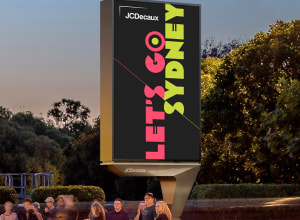
The French company JCDecaux has taken over one of the biggest out-of-home media contracts in Australia, Sydney Trains, and has big plans to upgrade the network with high resolution digital screens.
The deal, via a competitive tender, took more than two years and in the process the incumbent, oOh!Media, was dislodged.
JCDecaux takes over 1,500 sites from December 1 with pandemic restrictions foreshadowed to ease soon, releasing consumers from home to commute and spend. In 2019, pre COVID Sydney Trains recorded 420 million journeys per year.
The assets cover commuter journeys from rail concourse to platform, and more than double JCDecaux’s current digital roadside footprint in NSW.
And the NSW agency running trains, Transport for NSW, has significantly improved the flow of revenue from advertising.
The Sydney win gives the outdoor media group a range of rail assets across Australia, including Queensland Rail, Southern Cross Station (Melbourne’s biggest) and the Perth Transport Authority.
JCDecaux CEO Steve O’Connor told AdNews: “We're waiting on the results for Adelaide and, if successful, it will be a five capital city rail offering which has never been achieved before,” says O’Connor.
The commercials of the new Sydney agreement haven’t been released but typically such deals include a share of the advertising revenue for Sydney Trains and a guaranteed amount.
Transport for NSW has obviously extracted a far better deal. It says the contract promises to declutter stations while generating record revenue.
"Valued at more than half a billion dollars, these are the largest public transport advertising contracts in Australia, and will more than treble previous outdoor advertising revenue on the Sydney Trains network,” says the government agency.
Where will the money come from?
O’Connor at JCDecaux: “Most of the revenues will be digital but there is a very large amount of paper based signs that aren't all worthy of being digitised.
“There's some 1500 site displays that we can access. About a third of them will be digital but that will end up contributing to about 90% of the revenue once it's all built out.”
Daniel Cutrone, head of media at Avenue C, says the Sydney trains deal is a huge win.
“Sydney rail is a workhorse of an asset but has become the forgotten child in the commuter space of late,” he says.
“Putting a spotlight back on the format being part of the bigger JCD arsenal will help push the product to be able to reach all Sydney commuters, whether in the car, train, bus or walking.
“Over the last 18 months there has been caution when buying in and around public transport, as it’s seen the slowest returns to pre-pandemic levels. However, we anticipate that audiences will return following the upwards trends we saw with drivers/pedestrians.
“One of the biggest changes to the large format landscape across NSW we have seen in years, as JCDecaux bolsters its assets in both metro and regional areas growing their NSW portfolio significantly.
“This is a really exciting opportunity for advertisers to get on new and refurbished assets as they are rolled out across the greater Sydney area. More premium sites are ultimately a good thing for clients, with improved coverage and more choice.”
A commuter stopping at Wynyard station in Sydney’s CBD, one of Australia’s busiest, will in the future notice a few changes.
“Ii will have a better quality LCD network there,” says O’Connor. “And the tunnel, the Barangaroo Walk, will have some really great new digital signs to capitalise on that big flow through of traffic that happens from Wynyard down to Barangaro.
“In those interior environments, we're also going to be looking at developing opportunities for premium video, and as you know, premium videos have really driven the online market for some time now, so we're going to try and capitalise on that trend.
“But it's not just about the rail stations. They provide a really good size audience and importantly for us they spend a lot of time dwelling in those environments, so that creates a really strong and engaging advertising proposition.
“But the mainstay of the revenue is actually generated from the roadside digital billboards. That's the biggest part of the contract, in terms of the revenue contribution to the overall pie.
“You'll see a very considerable expansion of the digital signs across the landholding of Sydney Trains, both in metropolitan, and also regional. We've also picked up the regional area as well and that extends up to Newcastle, down past Wollongong, and going towards Nowra.
Steve O’Connor says advertisers have a tendency to buy across a portfolio of different outdoor formats.
“We're introducing a high quality portrait digital format,” he says. “Typically exterior roadside digital formats are normally landscape but we introduced a higher quality portrait format at some of the key locations around the center of the network and we'll provide a different advertising opportunity.”
JCDecaux’s plans include high impact 4.5m x 2.5m digital video screens suspended from the walls in rail concourse areas.
In Wynyard, these will be positioned above the York Street escalators. Existing portrait digital displays will be replaced with close to 300 new 75-inch screens.
Have something to say on this? Share your views in the comments section below. Or if you have a news story or tip-off, drop us a line at adnews@yaffa.com.au
Sign up to the AdNews newsletter, like us on Facebook or follow us on Twitter for breaking stories and campaigns throughout the day.


